Birth, Life and Death Waves
Good Corporation, Google, has done a lot of good deeds, and for this people loved it. Then came Facebook, which everyone liked too. And whether jealousy, or envy changed something in the minds of good wizards, and they began to look for a way to destroy Facebook. They even had such a corporate term appeared - WWF (War with Facebook), and special “commanders” were appointed, responsible for this war, a sort of anti-cykerbergs. General was appointed Win Kundotra.
At that time, the brothers Lars and Jens Rasmussen, known for their start-up Google Maps, caught fire with a new idea: the service of communication and collaboration (later - Google Wave). And Google decided to invest in the project in many respects precisely because they saw in it a weapon against Facebook. As a result, the evil anti-Tuckerberg was entrusted to oversee the development of the Rasmussen idea. In our opinion, it is this discrepancy between the mission and the idea of Wave that led to fatal mistakes in the project. The moral is trivial: envy and jealousy do not lead to good.
Service Rizzoma continues to develop the concept of Google Wave. Naturally, we do not want to repeat the same mistakes, but it is important not to miss the best that was in service. Therefore, we conducted a survey among GW users of 500 teams. Here are the results.
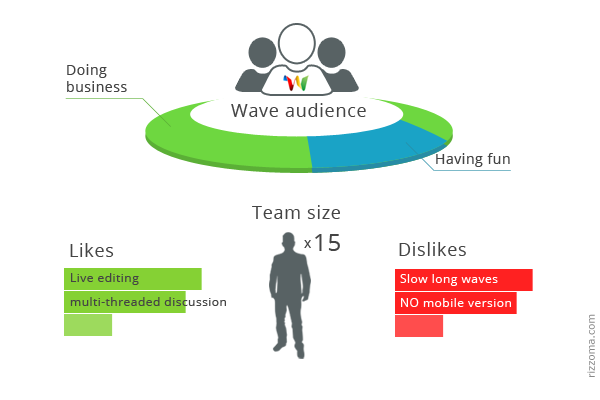
')
According to our estimates and information from secret sources, by November 2011 the wave had from 100 to 300 thousand active users. Among them: web developers, radio groups, photographers, professors, government bureaucrats, lawyers, venture capitalists, fashionable owners of luxury boutiques, builders.

Google Wave user activity. Alternative tag cloud view.
In order to understand what exactly the users are doing in the wave, we asked them: “What did you use Google Wave for the most part?”. As a result, we saw an interesting picture of the life of a certain average project:
1. Asynchronous research work. Everyone at one time, the project participants are not too many.
2. Brainstorming is usually deleted. From 5 to 15 people simultaneously in one wave.
3. Drafting documents. The bulk of the run and a couple of activists bring the work to the end.
4. Support knowledge base. The project is essentially complete, and the wave is later used as a wiki.
The average team size was 15 people:

A significant number of users stated that they used GW both for solving business problems and for personal communication and entertainment. In addition, we found it curious that some users were participants in several teams, each of which worked in a wave.
To the question “What do you think was the best in GW?” Most of the respondents agreed that the possibility of real-time collaboration was really cool at Wave. Take a look at how the word Collaboration stands out in this tag cloud:
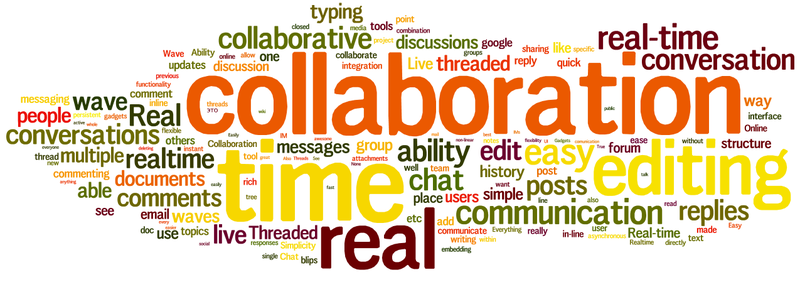
12% of the audience agrees with the concept of Lars and Jens Rasmussenov: "The wave unites the usual messenger, e-mail, forums, blogs and a social network." Many people point out in this the difference between the wave and Google Docs. For those who have not seen Google Wave, here is a screenshot of the interface .
It is also interesting to note that Google's top management relied on Wave in its long-standing battle with Facebook.
Based on the answers of the respondents, we divided users into groups according to the functions that they considered best:
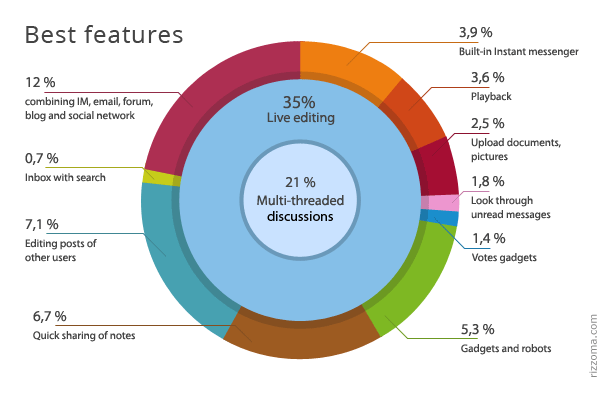
The best features of GW in terms of users
Wave developers had high hopes for gadgets and robots. However, only a few found them useful. Although it is worth highlighting the very useful gadget for voting.
In general, there was a lot of good in Wave. A reasonable question arises: why such a good service did not become popular with a wide audience?
At its very start, the project encountered many technical difficulties:
We received this information from the developers of Google Wave. But what users said:
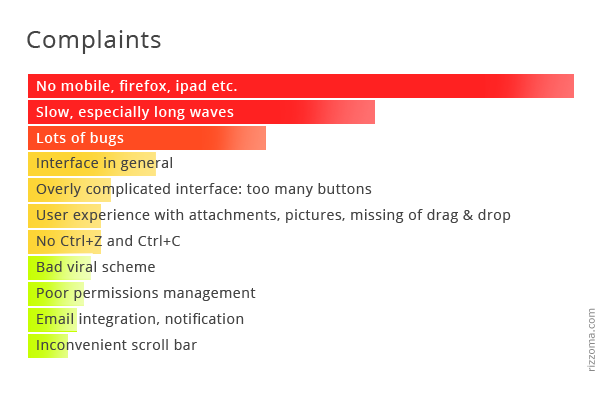
User complaints: another view of this data
According to our information, the target audience for the Waves was simply users (consumers). The wave development team was tasked to recruit a million active users in a year. On the scale of Google and with PR support from Google, the task is not so difficult. If you look at the problems of the Wave from the point of view of the audience engagement and marketing model, you see very serious omissions:
Slightly less than six months after launch, it became clear that the coveted million is not recruited. At the same time, it became even clearer that the Wave is much more interesting to business than to “idle” users. In theory, the value of a single business user is much higher than the “idle” user and the success criterion in this segment is clearly lower. For top management, leaving the consumer market meant giving up the idea of defeating Facebook.
The decision of Google’s top management can be understood on the one hand: if Google Wave is focused on a business audience, you’ll have a serious competition with Google Docs. Actually, it was in doxa that some features of the Wave moved.
From our point of view, the main reason for failure is the lack of a well-thought-out user experience. At Google presentations, we can see how well and lively users begin to communicate in a wave. What happened in practice? An interesting wave attracted new people, and the number of messages there grew avalanche-like. Here you, a simple American, decided to go to the Wave in the evening to chat about the liquidity crisis and see either an empty wave with two greetings or a huge sheet in which nothing is clear for a long time:
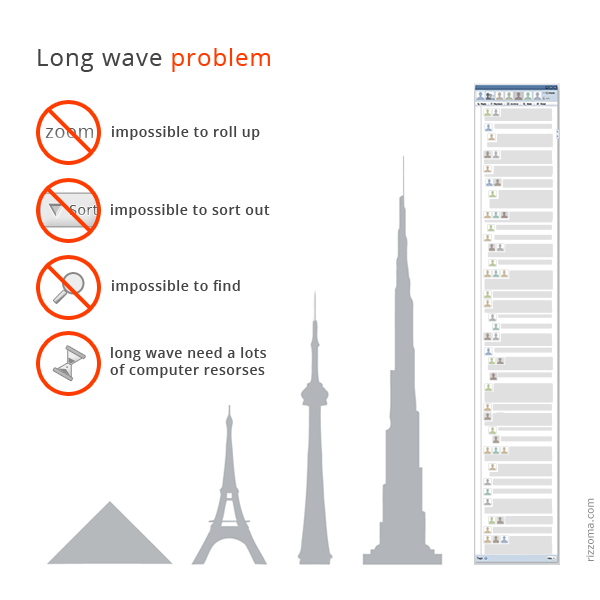
In general, goodbye, Google Wave. We loved you. We send greetings to the ideologists of the project Lars and Jens Rasmussen.
At that time, the brothers Lars and Jens Rasmussen, known for their start-up Google Maps, caught fire with a new idea: the service of communication and collaboration (later - Google Wave). And Google decided to invest in the project in many respects precisely because they saw in it a weapon against Facebook. As a result, the evil anti-Tuckerberg was entrusted to oversee the development of the Rasmussen idea. In our opinion, it is this discrepancy between the mission and the idea of Wave that led to fatal mistakes in the project. The moral is trivial: envy and jealousy do not lead to good.
Service Rizzoma continues to develop the concept of Google Wave. Naturally, we do not want to repeat the same mistakes, but it is important not to miss the best that was in service. Therefore, we conducted a survey among GW users of 500 teams. Here are the results.

')
Who uses Google Wave? What for?
According to our estimates and information from secret sources, by November 2011 the wave had from 100 to 300 thousand active users. Among them: web developers, radio groups, photographers, professors, government bureaucrats, lawyers, venture capitalists, fashionable owners of luxury boutiques, builders.

Google Wave user activity. Alternative tag cloud view.
In order to understand what exactly the users are doing in the wave, we asked them: “What did you use Google Wave for the most part?”. As a result, we saw an interesting picture of the life of a certain average project:
1. Asynchronous research work. Everyone at one time, the project participants are not too many.
2. Brainstorming is usually deleted. From 5 to 15 people simultaneously in one wave.
3. Drafting documents. The bulk of the run and a couple of activists bring the work to the end.
4. Support knowledge base. The project is essentially complete, and the wave is later used as a wiki.
The average team size was 15 people:

A significant number of users stated that they used GW both for solving business problems and for personal communication and entertainment. In addition, we found it curious that some users were participants in several teams, each of which worked in a wave.
Live Collaboration - the best that was in the Wave
To the question “What do you think was the best in GW?” Most of the respondents agreed that the possibility of real-time collaboration was really cool at Wave. Take a look at how the word Collaboration stands out in this tag cloud:

12% of the audience agrees with the concept of Lars and Jens Rasmussenov: "The wave unites the usual messenger, e-mail, forums, blogs and a social network." Many people point out in this the difference between the wave and Google Docs. For those who have not seen Google Wave, here is a screenshot of the interface .
It is also interesting to note that Google's top management relied on Wave in its long-standing battle with Facebook.
Based on the answers of the respondents, we divided users into groups according to the functions that they considered best:

The best features of GW in terms of users
Wave developers had high hopes for gadgets and robots. However, only a few found them useful. Although it is worth highlighting the very useful gadget for voting.
In general, there was a lot of good in Wave. A reasonable question arises: why such a good service did not become popular with a wide audience?
The problem of long waves led to the death of Google Wave
At its very start, the project encountered many technical difficulties:
- The guys had to rewrite Chrome for the sake of the wave. Problems with other browsers have not been resolved.
- A serious module for integrating with Gmail was conceived, but many technical issues could not be overcome, and the project was abandoned.
- It turned out that the wave eats a lot of resources and is very demanding on the quality of the Internet connection.
We received this information from the developers of Google Wave. But what users said:

User complaints: another view of this data
According to our information, the target audience for the Waves was simply users (consumers). The wave development team was tasked to recruit a million active users in a year. On the scale of Google and with PR support from Google, the task is not so difficult. If you look at the problems of the Wave from the point of view of the audience engagement and marketing model, you see very serious omissions:
- the invitation tool to the service of new users worked very poorly, and a month after the opening, it broke down and did not work anymore
- there were no tools for publishing content from Wave to public places. More precisely were, but not for the simple user.
- there was no integration with Facebook. I wonder how Google intended to lure the audience, if there is no possibility to log in under your Facebook account? But nothing of the likes and sharing is generally silent.
Slightly less than six months after launch, it became clear that the coveted million is not recruited. At the same time, it became even clearer that the Wave is much more interesting to business than to “idle” users. In theory, the value of a single business user is much higher than the “idle” user and the success criterion in this segment is clearly lower. For top management, leaving the consumer market meant giving up the idea of defeating Facebook.
The decision of Google’s top management can be understood on the one hand: if Google Wave is focused on a business audience, you’ll have a serious competition with Google Docs. Actually, it was in doxa that some features of the Wave moved.
From our point of view, the main reason for failure is the lack of a well-thought-out user experience. At Google presentations, we can see how well and lively users begin to communicate in a wave. What happened in practice? An interesting wave attracted new people, and the number of messages there grew avalanche-like. Here you, a simple American, decided to go to the Wave in the evening to chat about the liquidity crisis and see either an empty wave with two greetings or a huge sheet in which nothing is clear for a long time:
- And if you ask someone a question in such a long wave, the addressee simply will not see it.
- The search tool in Wave was also not thought out.

In general, goodbye, Google Wave. We loved you. We send greetings to the ideologists of the project Lars and Jens Rasmussen.
Source: https://habr.com/ru/post/139475/
All Articles